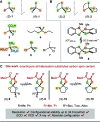All-Heteroatom-Substituted Carbon Spiro Stereocenters: Synthesis, Resolution, Enantiomeric Stability, and Absolute Configuration
- PMID: 40464057
- PMCID: PMC12200235
- DOI: 10.1021/jacs.5c06394
All-Heteroatom-Substituted Carbon Spiro Stereocenters: Synthesis, Resolution, Enantiomeric Stability, and Absolute Configuration
Abstract
Chiral tetra-heterosubstituted methanes (i.e., tetraoxa and azatrioxa carbon spiro stereocenters) are synthesized under CpRu catalysis, using cyclic carbonates and carbamates as substrates and α-diazo-β-ketoesters as reagents. Single enantiomers, isolated by chiral stationary phase chromatography, display chiroptical properties, from gabs ∼10-5 to ∼10-4, which, together with TD-DFT calculations, provide robust absolute configuration assignments. Crystalline spiro diastereomers were also obtained, confirming further the structural and configurational assignments. Using enantioselective dynamic chromatography, remarkable enantiomerization barriers were determined for the ortho-carbonates and ortho-carbamates, with values of up to 27.6 and 34.6 kcal/mol (half-lives 227 days and >84,000 years at 25 °C, respectively). DFT further elucidates the origin of this large difference pointing toward preferred C-O or C-N bond cleavages in the rate-determining step of the SN1-like mechanism.
Figures





Similar articles
-
Electronic cigarettes for smoking cessation.Cochrane Database Syst Rev. 2021 Sep 14;9(9):CD010216. doi: 10.1002/14651858.CD010216.pub6. Cochrane Database Syst Rev. 2021. Update in: Cochrane Database Syst Rev. 2022 Nov 17;11:CD010216. doi: 10.1002/14651858.CD010216.pub7. PMID: 34519354 Free PMC article. Updated.
-
Electronic cigarettes for smoking cessation.Cochrane Database Syst Rev. 2022 Nov 17;11(11):CD010216. doi: 10.1002/14651858.CD010216.pub7. Cochrane Database Syst Rev. 2022. Update in: Cochrane Database Syst Rev. 2024 Jan 8;1:CD010216. doi: 10.1002/14651858.CD010216.pub8. PMID: 36384212 Free PMC article. Updated.
-
Probiotics for preventing urinary tract infection in people with neuropathic bladder.Cochrane Database Syst Rev. 2017 Sep 8;9(9):CD010723. doi: 10.1002/14651858.CD010723.pub2. Cochrane Database Syst Rev. 2017. PMID: 28884476 Free PMC article.
-
Experiences of gynecological cancer patients receiving care from specialist nurses: a qualitative systematic review.JBI Database System Rev Implement Rep. 2017 Aug;15(8):2087-2112. doi: 10.11124/JBISRIR-2016-003126. JBI Database System Rev Implement Rep. 2017. PMID: 28800057
-
Systemic pharmacological treatments for chronic plaque psoriasis: a network meta-analysis.Cochrane Database Syst Rev. 2021 Apr 19;4(4):CD011535. doi: 10.1002/14651858.CD011535.pub4. Cochrane Database Syst Rev. 2021. Update in: Cochrane Database Syst Rev. 2022 May 23;5:CD011535. doi: 10.1002/14651858.CD011535.pub5. PMID: 33871055 Free PMC article. Updated.
References
-
- Cahn R. S., Ingold C., Prelog V.. Specification of Molecular Chirality. Angew. Chem., Int. Ed. 1966;5:385–415. doi: 10.1002/anie.196603851. - DOI
- Prelog V., Helmchen G.. Basic Principles of the CIP-System and Proposals for a Revision. Angew. Chem., Int. Ed. 1982;21:567–583. doi: 10.1002/anie.198205671. - DOI
-
- Aida T., Meijer E. W., Stupp S. I.. Functional Supramolecular Polymers. Science. 2012;335:813–817. doi: 10.1126/science.1205962. - DOI - PMC - PubMed
- Zhang L., Qin L., Wang X., Cao H., Liu M.. Supramolecular Chirality in Self-Assembled Soft Materials: Regulation of Chiral Nanostructures and Chiral Functions. Adv. Mater. 2014;26:6959–6964. doi: 10.1002/adma.201305422. - DOI - PubMed
- Mabesoone M. F. J., Palmans A. R. A., Meijer E. W.. Solute–Solvent Interactions in Modern Physical Organic Chemistry: Supramolecular Polymers as a Muse. J. Am. Chem. Soc. 2020;142:19781–19798. doi: 10.1021/jacs.0c09293. - DOI - PMC - PubMed
- Mondal A., Toyoda R., Costil R., Feringa B. L.. Chemically Driven Rotatory Molecular Machines. Angew. Chem., Int. Ed. 2022;61:e202206631. doi: 10.1002/anie.202206631. - DOI - PMC - PubMed
- Pal T., Chaudhuri D.. Chiral and Morphological Anisotropy of Supramolecular Polymers Shaped by a Singularity in Solvent Composition. J. Am. Chem. Soc. 2023;145:2532–2543. doi: 10.1021/jacs.2c12253. - DOI - PubMed
- Sheng J., Pooler D. R. S., Feringa B. L.. Enlightening dynamic functions in molecular systems by intrinsically chiral light-driven molecular motors. Chem. Soc. Rev. 2023;52:5875–5891. doi: 10.1039/D3CS00247K. - DOI - PMC - PubMed
- Fu K., Zhao Y., Liu G.. Pathway-directed recyclable chirality inversion of coordinated supramolecular polymers. Nat. Commun. 2024;15:9571. doi: 10.1038/s41467-024-53928-5. - DOI - PMC - PubMed
- Chae K., Mohamad N. A. R. C., Kim J., Won D.-I., Lin Z., Kim J., Kim D. H.. The promise of chiral electrocatalysis for efficient and sustainable energy conversion and storage: a comprehensive review of the CISS effect and future directions. Chem. Soc. Rev. 2024;53:9029–9058. doi: 10.1039/D3CS00316G. - DOI - PubMed
-
- Senkuttuvan N., Komarasamy B., Krishnamoorthy R., Sarkar S., Dhanasekaran S., Anaikutti P.. The significance of chirality in contemporary drug discovery-a mini review. RSC Adv. 2024;14:33429–33448. doi: 10.1039/D4RA05694A. - DOI - PMC - PubMed
- McVicker R. U., O′Boyle N. M.. Chirality of New Drug Approvals (2013–2022): Trends and Perspectives. J. Med. Chem. 2024;67:2305–2320. doi: 10.1021/acs.jmedchem.3c02239. - DOI - PMC - PubMed
- Bloom B. P., Paltiel Y., Naaman R., Waldeck D. H.. Chiral Induced Spin Selectivity. Chem. Rev. 2024;124:1950–1991. doi: 10.1021/acs.chemrev.3c00661. - DOI - PMC - PubMed
- Adamala K. P., Agashe D., Belkaid Y., Bittencourt D. M. d. C., Cai Y., Chang M. W., Chen I. A., Church G. M., Cooper V. S., Davis M. M., Devaraj N. K., Endy D., Esvelt K. M., Glass J. I., Hand T. W., Inglesby T. V., Isaacs F. J., James W. G., Jones J. D. G., Kay M. S., Lenski R. E., Liu C., Medzhitov R., Nicotra M. L., Oehm S. B., Pannu J., Relman D. A., Schwille P., Smith J. A., Suga H., Szostak J. W., Talbot N. J., Tiedje J. M., Venter J. C., Winter G., Zhang W., Zhu X., Zuber M. T.. Confronting risks of mirror life. Science. 2024;386:1351–1353. doi: 10.1126/science.ads9158. - DOI - PubMed
- Chowdhury R., Preuss M. D., Cho H.-H., Thompson J. J. P., Sen S., Baikie T. K., Ghosh P., Boeije Y., Chua X. W., Chang K.-W., Guo E., van der Tol J., van den Bersselaar B. W. L., Taddeucci A., Daub N., Dekker D. M., Keene S. T., Vantomme G., Ehrler B., Meskers S. C. J., Rao A., Monserrat B., Meijer E. W., Friend R. H.. Circularly polarized electroluminescence from chiral supramolecular semiconductor thin films. Science. 2025;387:1175–1181. doi: 10.1126/science.adt3011. - DOI - PubMed
-
- Mislow K., Siegel J.. Stereoisomerism and local chirality. J. Am. Chem. Soc. 1984;106:3319–3328. doi: 10.1021/ja00323a043. - DOI
LinkOut - more resources
Full Text Sources

